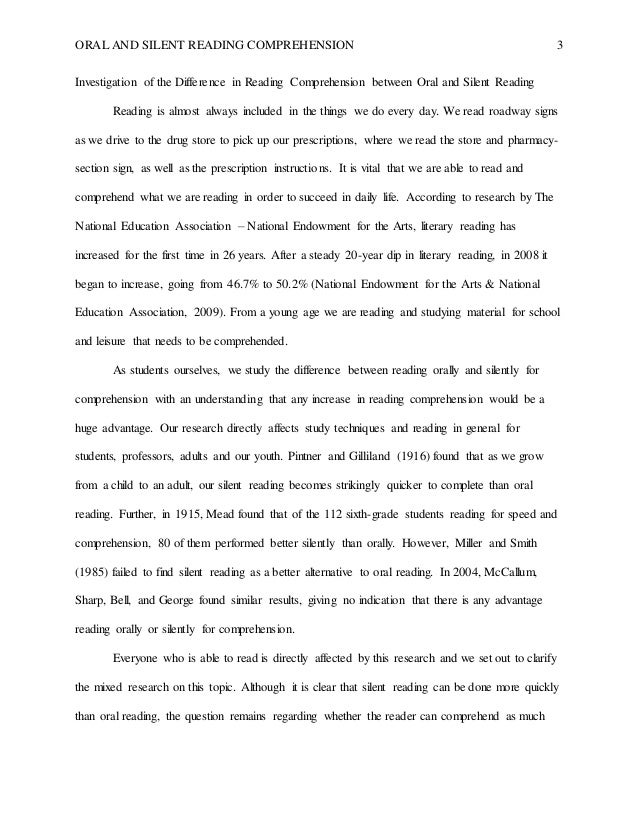There has been much debate surrounding whether oral or silent reading is more beneficial in developing the skills and fluency of struggling readers. Here, the educators at Lexplore explain the differences between oral and silent reading techniques, what studies show regarding the benefits of each type of exercise and how a balance of both oral and silent reading may be optimal.

What are Oral Reading and Silent Reading Techniques?
At the same time, the panel admits that it 'does not negate the positive influence independent silent reading time may have, nor the possibility that wide independent reading significantly influences vocabulary development and reading comprehension.' They simply call for more well-designed studies. Knowing the differences between oral and silent reading is vital to an individual's educational lifetime: Oral reading provides the thought from the printed page, while silent readers absorb the thought from the text. Oral reading actually follows an instant recognition of a thought, while silent readers immediately get.
- 20 tasks to accompany silent reading and assess students' comprehension. A range of activities designed to develop creativity, numeracy and literacy skills while keeping students focused on their reading. Subjects: Balanced Literacy, Reading, Literature. Grades: 7th, 8th, 9th, 10th.
- To model good silent reading practices and to demonstrate an interest in books and a love of literature, spend the first five minutes looking at books, too. Encourage those students who struggle with reading or are prereaders to picture-read the story and connect words from the text to the pictures.



Silent Reading Comprehension Strategies
Oral reading is the act of reading printed or written text aloud, and is often used by teachers to track and measure a student’s overall reading ability including reading accuracy, pronunciation, fluency, comprehension and understanding of punctuation. Oral reading can allow a teacher to directly observe a child’s reading skills, including decoding, fluency, and prosody (tone and expression). Many teachers frequently employ silent reading to build fluency. Sustained silent reading is the practice of having students read silently for a specified period of time each day. Some schools include adults in this practice, which may be known as DEAR (Drop Everything And Read) time.
What Does the Literature Say About Oral vs. Silent Reading?
Educators and researchers have debated for decades about whether oral reading or silent reading is more beneficial to struggling readers. Some researchers do not favor silent reading, despite its popularity in the classroom, on the grounds that there is not enough evidence that silent reading exercises lead to improved reading achievement. However, other researchers in defense of silent reading exercises argue that there are ways to successfully implement silent reading in theclassroom to boost students’ interest in reading and improve their fluency and motivation. Children's books about teddy bears. Support for this practice can be found in the book Revisiting Silent Reading by Elfrieda H. Hiebert and D. Ray Reutzel. Proponents of oral reading claim the practice is a sure way to improve students’ fluency, pronunciation skills and overall accuracy, while opponents argue that oral reading is not as necessary a skill as silent reading, particularly for older children.
Is A Combination of Oral and Silent Reading Practices Optimal?

A highly regarded study conducted at Arkansas State University, Comprehension and Rate: Oral vs. Silent Reading For Low Achievers, focused on the techniques of oral reading and silent reading for students who struggled with reading comprehension. The study found that, despite many professionals in the field almost exclusively favoring silent reading over oral reading, a combination of both oral and silent reading, based on the individual needs of the students, is potentially the best way to increase fluency and comprehension of struggling students. In addition, the research concluded that purposeful, intentional oral reading should be given more emphasis in elementary classrooms than it has been in the past. Ultimately this study, along with additional resources focusing on the benefits of oral and silent reading, points to the a combination of oral and silent reading as optimal. Silent reading can increase a student’s understanding of a text and motivation to read, while oral reading allows educators to track the fluency, pronunciation, accuracy and overall progress of their struggling readers.
Speak to a Lexplore Professional About Best Practices for Helping Your Struggling Readers
Silent Reading Comprehension Assessment
According to many literacy researchers and professionals, there are benefits to implementing both oral reading and silent reading exercises in your classroom to increase the proficiency of your struggling readers. The educators at Lexplore are passionate about helping struggling readers by ensuring you have the tools you need to understand each student’s reading needs. Lexplore’s state-of-the-art, eye-tracking and AI software can analyze a student’s reading level in just a few minutes and then provide you with recommendations for instruction. For more information contact the educators at Lexplore today.

Comments are closed.